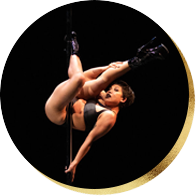Tips & Tricks: Training Mindset vs. Performance Mindset

When you are practicing for a competition (a virtual competition these days), what is your main focus? Is it your tricks, your stamina, your transitions, or your low flow? With all of these being physical, how much time are you training in the right mindset? Having the “right” mindset does not mean that you have to channel your inner Little Miss Sunshine to the pole. There are actually 2 types of mindsets from the perspective of sport and performance psychology: training mindset and performance mindset. One is just as important as the other.
Training Mindset
The training mindset is where your headspace is at most of the time when you are in class or practicing.. You learn, you fail, you correct your mistakes. You leave your ego at the door and focus on improvements. It is the mindset that you have when you film yourself and drag that time bar on your phone second by second to make sure every detail is executed to your expectations (and toes are always pointed, of course).
Performance Mindset
The performance mindset, or competition mindset as some may call it, is the time when you let go and trust your training. You stop overthinking and start enjoying the automaticity (muscle memory) of your body. Instead of stressing on minute details, you try to tell the story, show your emotions, convey your feelings in your movements. Same as any other trick and transition, acquiring a performance mindset requires a lot of practice. Here are some tips of what you can do to get into your performance mindset more quickly:
- Set aside at least 15 minutes at every practice solely for performing your piece full out. When the time comes, get to it without any hesitation.
- Have a simple but yet flexible routine to increase your readiness to perform when that 15 minutes comes. For example, putting on your heels (if applicable), listening to a crowd-cheering audio, or even putting on your lipstick (Use chapstick if you forgot your lipstick. Flexibility right there!). Go straight into performance mode right after.
- Visualize! Close your eyes, imagine the setting you will be at during your competition or performance. Describe the 5 senses you can feel on that stage, imagine how your body will feel right before the start of the real performance. Write yourself a script and record your own voice if possible. Listen to it before you get into the performance mindset as an addition to tip #2.
- Cue word. Find a simple word or phrase that is meaningful to you. Make it a trigger point for your pre-performance routine or visualization. For example, I use the phrase “Let’s feel it” because feelings and emotions are the most important aspects in my performance. This can also ground myself more and overthink less. If you have enough practice, a simple word can condition yourself to shift from your training mindset to performance mindset.
Hope this post gives you some new ideas of how to practice and prepare for your competitions! Good luck!
Guest Blogger - Aretha Chui
Aretha Chui is a master graduate from the Sport and Performance Psychology Program at the University of Denver. She is one of the few that joined the field with the background of performing arts. She has been a dancer for over a decade and has been a pole dancer for almost 5 years. Witnessing the importance, and also the lack of performance psychology in the field of performing arts, she is devoted to dedicating her knowledge, skills and abilities to the dance and aerial communities to improve performance and well-being. She consults from a person-centered approach with her clients to strive for personal growth as a dancer, as a performer and as a person. Originally from Hong Kong, Aretha values the importance of cultural diversity in her consulting. She strives to create an authentic and safe environment when working with teams and individuals.
About Pole Sport Organization

We believe that anyone, at any level, and any age should have a chance to be on stage. We are an inclusive event, meaning no submission videos, no prerequisites, and no required moves. Just sign up, and we'll see you at the show!
